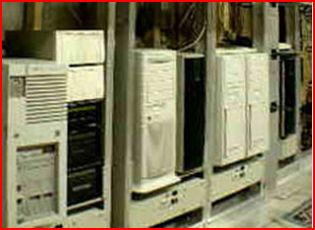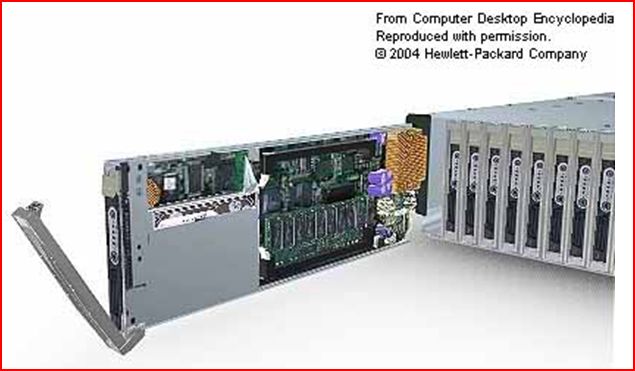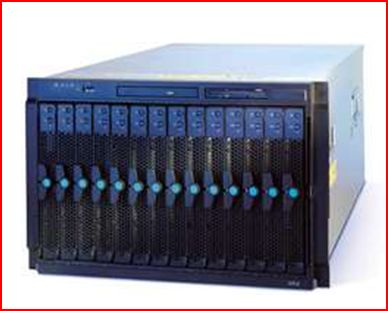2.2 Evolution: Difference between revisions
No edit summary |
No edit summary |
||
| (7 intermediate revisions by the same user not shown) | |||
| Line 1: | Line 1: | ||
For many years, traditional standalone servers grew larger and faster, taking on more and more tasks as networked computing expanded. New servers were added to data centers as the need arose, often as a quick fix with little coordination or planning; it was not unusual for data center operators to discover that servers had been added without their knowledge. The resulting complexity of boxes and cabling became a growing invitation to confusion, mistakes, and inflexibility. | For many years, traditional standalone servers grew larger and faster, taking on more and more tasks as networked computing expanded. New servers were added to data centers as the need arose, often as a quick fix with little coordination or planning; it was not unusual for data center operators to discover that servers had been added without their knowledge. The resulting complexity of boxes and cabling became a growing invitation to confusion, mistakes, and inflexibility. | ||
[[Image:Conventional Servers.jpg]] | |||
Figure : Conventional Servers | |||
Blade servers, first appearing in 2001, are a very simple and pure example of modular architecture – the blades in a blade server chassis are physically identical, with identical processors, ready to be configured and used for any purpose desired by the user. Their introduction brought many benefits of modularity to the server landscape – scalability, ease of duplication, specialization of function, and adaptability.Blade servers were developed in response to a critical and growing need in the datacenter: the requirement to increase server performance and availability without dramatically increasing the size, cost and management complexity of an ever growing data center. To keep up with user demand and because of the space and power demands of traditional tower and rackmount servers, data centers are being forced to expand their physical plant at an alarming rate. | Blade servers, first appearing in 2001, are a very simple and pure example of modular architecture – the blades in a blade server chassis are physically identical, with identical processors, ready to be configured and used for any purpose desired by the user. Their introduction brought many benefits of modularity to the server landscape – scalability, ease of duplication, specialization of function, and adaptability.Blade servers were developed in response to a critical and growing need in the datacenter: the requirement to increase server performance and availability without dramatically increasing the size, cost and management complexity of an ever growing data center. To keep up with user demand and because of the space and power demands of traditional tower and rackmount servers, data centers are being forced to expand their physical plant at an alarming rate. | ||
[[Image:Blade Server.jpg]] | |||
But while these classic modular advantages have given blade servers a growing presence in data centers, their full potential awaits the widespread implementation of one remaining critical capability of modular design: fault tolerance. Fault tolerant blade servers – ones with built-in “failover” logic to transfer operation from failed to healthy blades – have only recently started to become available and affordable. The reliability of such fault tolerant servers will surpass that of current techniques involving redundant software and clusters of single servers, putting blade servers in a position to become the dominant server architecture of data centers. With the emergence of automated fault tolerance, industry observers predict rapid migration to blade servers over the forthcoming years. | But while these classic modular advantages have given blade servers a growing presence in data centers, their full potential awaits the widespread implementation of one remaining critical capability of modular design: fault tolerance. Fault tolerant blade servers – ones with built-in “failover” logic to transfer operation from failed to healthy blades – have only recently started to become available and affordable. The reliability of such fault tolerant servers will surpass that of current techniques involving redundant software and clusters of single servers, putting blade servers in a position to become the dominant server architecture of data centers. With the emergence of automated fault tolerance, industry observers predict rapid migration to blade servers over the forthcoming years. | ||
The Terian EdgeXPS® 714-132 is powered by the latest Dual-Core Intel® Xeon® 5100 Series Processor and can support up to 14- dual processor Blade Servers (28 total processors) in a single 7U chassis. <br> | |||
[[Image:Terian EdgeXPS® 714-132 .jpg]] | |||
Latest revision as of 01:44, 6 September 2007
For many years, traditional standalone servers grew larger and faster, taking on more and more tasks as networked computing expanded. New servers were added to data centers as the need arose, often as a quick fix with little coordination or planning; it was not unusual for data center operators to discover that servers had been added without their knowledge. The resulting complexity of boxes and cabling became a growing invitation to confusion, mistakes, and inflexibility.
 Figure : Conventional Servers
Figure : Conventional Servers
Blade servers, first appearing in 2001, are a very simple and pure example of modular architecture – the blades in a blade server chassis are physically identical, with identical processors, ready to be configured and used for any purpose desired by the user. Their introduction brought many benefits of modularity to the server landscape – scalability, ease of duplication, specialization of function, and adaptability.Blade servers were developed in response to a critical and growing need in the datacenter: the requirement to increase server performance and availability without dramatically increasing the size, cost and management complexity of an ever growing data center. To keep up with user demand and because of the space and power demands of traditional tower and rackmount servers, data centers are being forced to expand their physical plant at an alarming rate.

But while these classic modular advantages have given blade servers a growing presence in data centers, their full potential awaits the widespread implementation of one remaining critical capability of modular design: fault tolerance. Fault tolerant blade servers – ones with built-in “failover” logic to transfer operation from failed to healthy blades – have only recently started to become available and affordable. The reliability of such fault tolerant servers will surpass that of current techniques involving redundant software and clusters of single servers, putting blade servers in a position to become the dominant server architecture of data centers. With the emergence of automated fault tolerance, industry observers predict rapid migration to blade servers over the forthcoming years.
The Terian EdgeXPS® 714-132 is powered by the latest Dual-Core Intel® Xeon® 5100 Series Processor and can support up to 14- dual processor Blade Servers (28 total processors) in a single 7U chassis.
